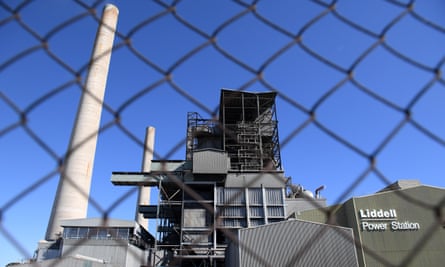Taskforce study does not back Scott Morrison’s claim that Liddell coal plant needs urgent replacing with 1,000 megawatts of new dispatchable electricity generation capacity

Last modified on Wed 16 Sep 2020 19.55 AEST
A Morrison government claim that new electricity generation is urgently needed to replace New South Wales’s Liddell coal plant is not backed by a taskforce report commissioned to assess the impact of its closure.
In a speech on Tuesday, Scott Morrison said the government had estimated 1,000 megawatts of new dispatchable electricity generation capacity would be needed to replace Liddell, which owner AGL has announced will close in early 2023.
The prime minister said the government would give the private sector until the end of April 2021 to reach final investment decisions on that amount of power, and would step in if others did not. The taxpayer-owned Snowy Hydro is developing plans to build a gas generator nearby at Kurri Kurri.
On Wednesday, the government released the advice it received in April from a taskforce set up in conjunction with the NSW government to assess the impact of Liddell’s closure.
The taskforce does not find that 1,000MW of additional dispatchable electricity would be needed. It listed a range of energy committed and probable projects that it found would be “more than sufficient” to maintain a high level of power grid reliability as Liddell shut.
They include confirmed upgrades to AGL’s Bayswater coal plant in NSW’s Hunter region, transmission links with Victoria and Queensland, and expected battery and gas projects that were then in the advanced stage of planning.
It is consistent with Aemo last month finding only an additional 154MW would be needed in NSW by 2023 to meet the electricity grid’s strict “reliability standard”, and that well in excess of that amount of new power capacity had since been announced.
The taskforce recommended that if the federal and NSW governments believed more needed to be done to ensure grid reliability as coal plants closed, then they should work with other states to develop a national policy framework to address the issue.
It also suggest governments focus on developing “demand-side measures”, including improved energy efficiency and demand response measures that pay consumers and businesses to reduce consumption at peak times.
The taskforce does not back the Morrison government’s longstanding push, dropped only recently, for AGL to either keep Liddell open beyond 2023 or sell it to a new operator. It found it was not likely to be commercially viable due to the investment needed to keep it operational and purchase coal supplies. It warned an extension of its life could undermine the business case for other investments.
The taskforce found Liddell’s closure was likely to increase average wholesale electricity prices, but not as significantly as the rise experienced when Victoria’s Hazelwood plant shut in 2017. It stressed the modelling of prices was indicative only, and not certain.
In its response, the Morrison government said it accepted six of the taskforce’s recommendations, but it would “not risk the affordability, reliability and security of the NSW energy system on the hope sufficient investment in like-for-like capacity could eventuate”.
It said the 1,000MW “dispatchable investment target” was based on modelling carried out for the taskforce. The modelling has not been released.
Richie Merzian, climate and energy director at the Australia Institute, said the report confirmed there was no basis for the “arbitrary” 1,000MW target.
“In fact, the report finds only around 215MW of new dispatchable power is needed when Liddell closes, and that private projects that would provide over four times that amount of dispatchable energy have already been publicly announced,” he said.
The Greens leader, Adam Bandt, said the report found a mix of renewable energy, storage and some gas, as proposed by the industry, was a cheaper option to replace Liddell than gas-fired electricity.
He accused the government of sitting on the report since April, and hiding the modelling behind it because it did not support its “plan for a massive gas-fired overreach”. He call for the modelling to be released.
The NSW energy minister, Matt Kean, said he supported the federal government’s decision to replace Liddell, rather than extend its life. “We need to replace our ageing power plants before they close with the lowest cost new forms of generation,” he said.
No comments:
Post a Comment